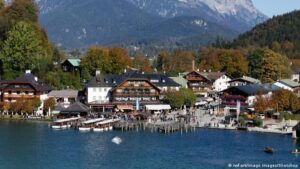Germany’s sustainable tourism is popular all over the world. Germans enjoy travelling. In their own nation as well, if not more so. The Corona epidemic has exacerbated this tendency. For many years, the Alps, coastlines, North German lakes, natural reserves, and river valleys have topped the list of tourist destinations. Germans have long shared a fondness for the richness of the countryside and sightseeing, recreation, and relaxation possibilities, with visitors from other countries. Prior to the epidemic, Germany was becoming a more popular tourist destination year after year.
What Is Sustainable Tourism:
Sustainable tourism refers to tourism that has more positive than negative consequences, particularly on the environment, the economy, and communities. Authentic, sustainable, and responsible tourism should improve the quality of life in places where people live as well as visit.
Germany’s Sustainable Tourism:
The COVID-19 pandemic has increased global traveller concern about sustainability. Unspoiled environment, wise resource management, and an emphasis on welfare are all gaining prominence. The German National Tourist Board (GNTB) recognizes this trend and has broadened the scope of its ‘Feel Good’ campaign in 2021. The GNTB promotes Destination Germany’s diverse offering of sustainable tourism.
The number of overnights increased to 495.6 million in 2019, with foreign visitors accounting for 89.9 million, a record. The upward trend in tourism to Germany began immediately after German reunification in 1990 and has since resulted in an 88 percent increase in the number of overnight stays by international tourists. Most recently, 75 percent of all international visitors came from Europe, particularly the Netherlands, Switzerland, the United Kingdom, and Italy, with the United States accounting for the remaining 7.5 percent. At the same time, the number of travelers from Asia and Africa was increasing. However, the Corona epidemic will halt this trend for the time being.

In 2021, ‘Feel Good’
The GNTB campaign comprises several towns, regions, and lodging providers that are particularly devoted to tourism sustainability. The ‘Feel Good’ campaign also highlights unique travel experiences that highlight sustainable products and services available at the destination. These activities allow visitors to interact with locals and learn about sustainability firsthand. Four clusters have been created to define better the offers: ‘Active Outdoors,’ ‘Education and Experiences,’ ‘Responsible Enjoyment,’ and ‘Sustainable Experiences in Towns and Cities.’ Tips for sustainable travel supplement the information provided, and a bilingual CO2 calculator allows visitors to log their trip’s emissions and offset them through local programs.

Eco-friendly, experience-oriented travel for all
There are several eco-friendly, experience-oriented travel possibilities within Germany’s transportation system. Its network is extensive, with links to remote locations and areas. As a result, it’s ideal for stress-free travel and a peaceful stay, and smooth, eco-friendly, experience-oriented travel.
German areas and attractions are continually developing innovative ways for its visitors to discover the local area while remaining environmentally conscious. For example, in major cities, bike rental services, electric bikes, and electric scooters are accessible in addition to the traditional bus and rail networks.
Buses and railroads stop at the best-isolated bike trails and trekking routes, which will satisfy athletic travelers. If you forgot your bike at home, you might rent trekking, mountain bikes, or even electric ones. Paddleboards, canoes, and kayaks are available for visitors as well to use on the river. There are also climate-neutral solar-powered boats in some regions.
Popular UNESCO World Heritage Sites:
The top worldwide visitor attractions, according to a study performed by the German National Tourist Board, include classics such as Neuschwanstein Castle and Cologne Cathedral. Popular UNESCO World Heritage sites include the Sanssouci Palace in Potsdam and Classical Weimar.
Movement, like culture, plays an important role in Germany’s attractiveness. The network of hiking trails alone, which is around 200,000 kilometers long, provides extraordinarily good conditions and wonderful vistas, for example, on routes through national parks or against the gorgeous Alps. On top of that, there are over 200 well-established long-distance bike paths covering tens of thousands of kilometers, such as the 1,131-kilometer-long Iron Curtain Trail or the 818-kilometer-long German Limes Cycle Route. Those searching for a cheap night’s stay can find lots of options, such as one of the 450 youth hostels or one of the nearly 3,000 campgrounds.
Sustainable Holidays & Eco-Friendly Travel:
In Germany, wellness is a hot issue. It contains distinctive elements like the river sauna at the Emser Therme thermal complex, as well as other feel-good amenities in spa towns like Bad Wörishofen and Bad Oeynhausen, which have Wilhelminian-era architecture. There are about 200 spa resorts in Germany that utilize a designation recognized by the “Deutscher Heilbäderverband,” or the German Association of Spa Resorts. The high level of medical care and assistance also draws a large number of visitors to Germany.
Travelers are increasingly concerned not just with their personal well-being, but also with environmental issues. Ecotourism and sustainable travel are becoming increasingly popular in Germany.
Organic farms provide vacation accommodations, and there are 106 natural parks and 16 biosphere reserves, all of which place a premium on sustainable development and biodiversity. Numerous initiatives guarantee that the disabled may travel freely in Germany in order for everyone to be able to move about effortlessly.
Sustainability commitment
Germany’s national rail company has taken several steps to conserve the environment, ecology, and resources and limit noise pollution and satisfy its sustainability targets.
Final Thought
So, what are your thoughts on Germany’s sustainable tourism? Was the GNTB’s action likely to boost tourism in their country? Kindly let us know your opinions in the comments below. While it may be a cliche, listening to your heart is something that never gets old. Your compassion determines your enthusiasm, desire, and love for people and things. Travel to different areas to keep your heart joyful and your mind stress-free. Never be afraid to pursue your interests.



